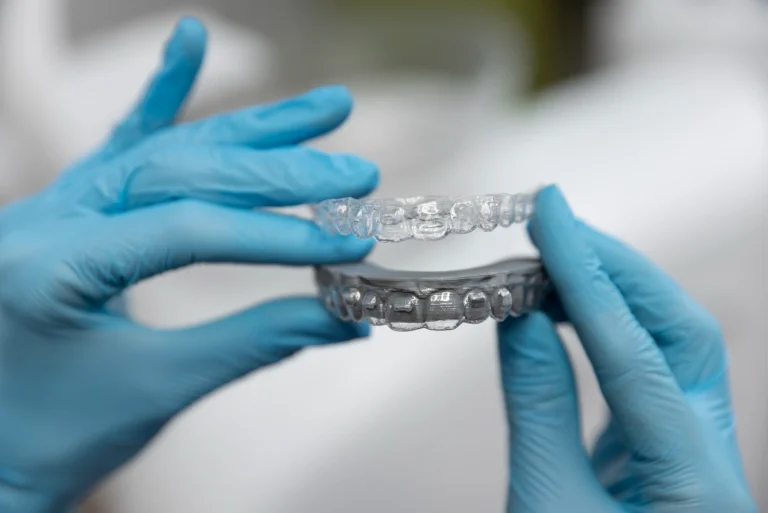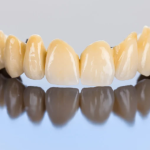Should You Choose Invisalign? What Every Patient Needs to Know Before Starting
Invisalign might be the sleekest orthodontic solution on the market, but before you commit to months of clear trays, tight schedules, and toothbrush multitasking, let’s pause.
It’s tempting, especially for working professionals. You’re in meetings, giving presentations, interviewing, dating—your smile is constantly on display, and metal brackets may feel like a step backward, not forward. But even Invisalign, with its nearly invisible design and quiet promise of correction, has its trade-offs.
This guide isn’t about selling you Invisalign. It’s about giving you the full picture—plain and simple.

So, What Exactly Is Invisalign and Why Do People Barely Notice It?
Invisalign is a clear aligner system designed to correct crooked, crowded, or spaced teeth using a series of custom-molded trays. No brackets, no wires—just flexible, medical-grade plastic that gradually nudges your teeth into new positions.
Each set of trays is worn for about 1–2 weeks before moving on to the next. Unlike braces, there’s no tightening involved. The pressure is subtle, almost unnoticeable at first. That’s part of the appeal: the treatment works while you’re out closing deals, meeting clients, or simply grabbing coffee with friends.
The aesthetics are a big deal, sure—but discretion isn’t the only reason professionals lean toward Invisalign. The convenience of removing trays before eating or brushing can’t be overstated. You’re not locked into a dental routine that makes you feel like a high schooler all over again.
But be careful—“removable” doesn’t mean optional. More on that in a moment.
Are You a Good Fit? The Smile, the Schedule, and the Science
Clear aligners don’t work well for every smile. Small gaps, somewhat crowded teeth, and modest bite problems are the mild to moderate cases where Invisalign works best. More conventional intervention can be required if you have rotated molars or severe jaw misalignment.
The good news? Invisalign’s technology keeps evolving. Attachments provide you more grip and control. They are those little tooth-colored dots you may have seen on someone’s teeth. Without extractions, interproximal reduction—the shaving of small pieces of enamel between teeth—can aid in creating space.
But dental health is also important. Prioritize treating any gum disease, unfilled cavities, and recent dental work such as crowns or implants. Your doctor should review your medical history and perform a comprehensive oral examination before approving.
And then there’s lifestyle.
Let’s be honest: wearing aligners 22 hours a day takes discipline. If you’re the kind of person who sips coffee slowly from 9 to noon, pops snacks between calls, or frequently forgets things in Uber rides—you might struggle. Success with Invisalign depends less on your teeth, more on your habits.
From Consultation to Retainer: A Realistic Look at the Process

Once you’ve been cleared for treatment, things move quickly. Your provider will take digital scans (think high-tech imaging, not goopy impressions), map your treatment virtually, and show you a time-lapsed preview of your projected results. It’s surprisingly satisfying.
After that, you’ll receive your first few trays—sometimes a whole batch. Expect to swap them out weekly or bi-weekly depending on your plan. Check-in appointments happen every 6–8 weeks, though some practices offer virtual monitoring.
But here’s what often gets glossed over: the daily grind.
You’ll be brushing after every meal—yes, even after snacking on almonds between meetings. Your trays need to stay clear and odor-free. Talking may sound slightly different for the first few days. And cleaning the trays? It’s not hard, but it’s a chore—one more thing to think about when your calendar’s already packed.
The process doesn’t end when the trays do, either. After treatment, you’ll need retainers to keep everything in place. They’re usually worn at night, sometimes indefinitely. Skip them, and the teeth may slowly shift back. It’s not punishment—it’s just biology.
Counting the Cost: Not Just Money, But Time and Mental Space
Let’s break it down.
Most Invisalign cases fall between $3,000 and $8,000. Insurance might cover a portion, especially if your plan includes orthodontic benefits. FSAs and HSAs help too, and many dental offices offer monthly payment plans.
But here’s what’s often overlooked: the mental cost.
There’s the scheduling—appointments, tray changes, reminders. There’s the commitment—no leisurely brunch without brushing, no “just one bite” without consequences. And there’s the vigilance—keeping trays from getting lost, cracked, or thrown out with a napkin.
Time-wise? Treatment usually lasts 6–18 months. That may sound short now, but it can feel long if you’re halfway through and tempted to cheat the 22-hour rule.
All that said, many patients will tell you it’s worth it. Not because it’s flashy, but because it’s flexible. Because they didn’t have to compromise professionalism to get straighter teeth. And because, for once, the process worked with their schedule, not against it.
Mistakes to Avoid and Strategies That Actually Help
People tend to focus on what Invisalign does. Let’s focus on what it requires.
Here’s what not to do:
- Don’t leave trays out for “just 30 minutes”—that turns into two hours fast.
- Don’t skip brushing and hope gum will cover it. It won’t.
- Don’t toss trays on a napkin during lunch. You’ll regret it.
And here’s what helps:
- Build a habit loop. Brush, rinse, insert. Same steps, same order, every day.
- Keep a spare case and toothbrush in your work bag or laptop sleeve.
- Set a recurring calendar alert—one for switching trays, another for check-ins.
If something feels off—trays not fitting right, gum irritation, stalled progress—speak up early. Most issues are fixable if caught soon enough. Silence delays solutions.
Choosing Confidence Not Just Convenience
So should you choose Invisalign?
Only if you’re ready to wear the trays more often than not. Only if you’re comfortable with structure, tiny sacrifices, and occasionally brushing your teeth in a Starbucks restroom. Only if you want subtlety and flexibility more than you want fast food freedom.
It’s not a shortcut. But for working professionals who value discretion, consistency, and steady results, it can be a remarkably smart move.
Not because it’s invisible. But because it respects your lifestyle—quietly, effectively, and on your terms.

More News /Article
- Trump administration shares new moves to dismantle more of the Education Department
- Brian Walshe, charged with murdering wife, pleads guilty to disposing of her body
- Baltimore bridge collapse that killed 6 was 'preventable,' federal investigators say
- Trump with MBS on Khashoggi: "A lot of people didn't like" him






